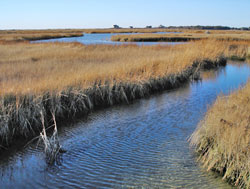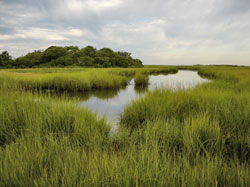 |
Study Site: The Great Sippewissett Salt Marsh
|
 |
|
The Great Sippewissett Salt Marsh:
Click thumbnails for larger images |
|
|
|
 |
 |
 |
|
|
|
|
|
 |
|
|
|
To investigate the effect of nutrient enrichment on salt marsh ecosystems, Valiela et al. (1973) established long-term experimental plots in Great Sippewissett salt marsh, on Buzzards Bay, Cape Cod, MA. Each circular plot is 10 m in radius and bisected by a small creek, and originally contained creek-bed, creek banks, low marsh and high marsh habitats.
Fertilization treatments were, and continue to be, applied to each plot approximately every two weeks throughout the April - October growing season. The experimental design included two of each treatment type, including untreated controls (C), as well as three dosages (LF, HF, XF) of a mixed N-P-K fertilizer derived from sewage sludge (Milorganite, 6%N, 0.75% as water soluble N and 5.75% as more slowly releasing, water-insoluble N) supplemented with urea such that the mixture is 10%N. LF plots received fertilizer treatments set at 10 times the recommended annual dosage for oats; HF plots received 30 times, and XF plots received 90 times this recommended dosage (0.9, 2.6 and 7.8 g N m2 wk1, respectively). A fifth treatment, U, received the same amount of N as HF plots, but entirely as urea instead of mixed fertilizer.
Vegetation
Tall-form Spartina alterniflora grows on creek banks, while intermediate and short-form S. alterniflora grows on low marsh areas. High marsh habitats are dominated by Spartina patens and Distichlis spicata, but S. alterniflora may still be present. Algal mats or the glasswort Salicornia europaea may be present in bare areas throughout the plots. More highly fertilized plots also have an increased presence of the high marsh species Distichlis spicata and Iva frutescens (Hersh 1996, Fox 2007).
|
|
